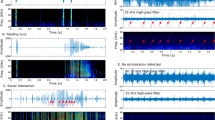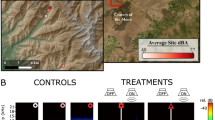Abstract
Echolocating bats can be divided into guilds according to their preferred habitat and foraging behaviour1,2,3,4, which coincide with distinct adaptations in wing morphology5 and structure of echolocation signals6. Although coarse structuring of niche space between different guilds is generally accepted, it is not clear how niches differ within guilds7,8,9,10, or whether there is fine-grained niche differentiation reflected in echolocation signal structure11,12. Using a standardized performance test, here we show clutter-dependent differences in prey-capture success for bats from five species of European Myotis. These species are morphologically similar, sympatric13, and all belong to the guild labelled “edge space aerial/trawling foragers”4. We further demonstrate a strong correlation between the prey-detection ability of the species and the respective search-call bandwidth. Our findings indicate that differences in echolocation signals contribute to within-guild niche differentiation. This is the first study relating sensory abilities of a set of potentially competing animal species to a direct measure of their respective foraging performance, suggesting an important role of sensory ecology in the structuring of animal communities.
This is a preview of subscription content, access via your institution
Access options
Subscribe to this journal
Receive 51 print issues and online access
$199.00 per year
only $3.90 per issue
Buy this article
- Purchase on Springer Link
- Instant access to full article PDF
Prices may be subject to local taxes which are calculated during checkout



Similar content being viewed by others
References
Aldridge, H. D. J. N. & Rautenbach, I. L. Morphology, echolocation and resource partitioning in insectivorous bats. J. Anim. Ecol. 56, 763–778 (1987)
Neuweiler, G. Auditory adaptations for prey capture in echolocating bats. Physiol. Rev. 70, 615–641 (1990)
Schnitzler, H.-U. & Kalko, E. K. V. Echolocation by insect-eating bats. Bioscience 51, 557–569 (2001)
Schnitzler, H.-U., Moss, C. F. & Denzinger, A. From spatial orientation to food acquisition in echolocating bats. Trends Ecol. Evol. 18, 386–394 (2003)
Norberg, U. M. & Rayner, J. M. V. Ecological morphology and flight in bats (Mammalia; Chiroptera): wing adaptations, flight performance, foraging strategy and echolocation. Phil. Trans. R. Soc. Lond. B 316, 335–427 (1987)
Fenton, M. B. Foraging behaviour and ecology of animal-eating bats. Can. J. Zool. 68, 411–422 (1990)
Findley, J. S. The structure of bat communities. Am. Nat. 110, 129–139 (1976)
McKenzie, N. L. & Rolfe, J. K. Structure of bat guilds in the Kimberley mangroves, Australia. J. Anim. Ecol. 55, 401–420 (1986)
Crome, F. H. J. & Richards, G. C. Bats and gaps: microchiropteran community structure in a Queensland rain forest. Ecology 69, 1960–1969 (1988)
Sleep, D. J. H. & Brigham, R. M. An experimental test of clutter tolerance in bats. J. Mamm. 84, 216–224 (2003)
Heller, K.-G. & von Helversen, O. Resource partitioning of sonar frequency bands in rhinolophoid bats. Oecologia 80, 178–186 (1989)
Kingston, T., Jones, G., Zubaid, A. & Kunz, T. H. Resource partitioning in rhinolophoid bats revisited. Oecologia 124, 332–342 (2000)
Krapp, F. in Handbuch der Säugetiere Europas Vol. 4/I (eds Niethammer, J. & Krapp, F.) 257–442 (Aula, Wiebelsheim, 2001)
Jones, G. & Rayner, J. M. V. Flight performance, foraging tactics and echolocation in free-living Daubenton's bats Myotis daubentoni (Chiroptera: Vespertilionidae). J. Zool. 215, 113–132 (1988)
Krull, D., Schumm, A., Metzner, W. & Neuweiler, G. Foraging areas and foraging behavior in the notch-eared bat, Myotis emarginatus (Vespertilionidae). Behav. Ecol. Sociobiol. 28, 247–253 (1991)
Schumm, A., Krull, D. & Neuweiler, G. Echolocation in the notch-eared bat, Myotis emarginatus. Behav. Ecol. Sociobiol. 28, 255–261 (1991)
Britton, A. R. C., Jones, G., Rayner, J. M. V., Boonman, A. M. & Verboom, B. Flight performance, echolocation and foraging behaviour in pond bats, Myotis dasycneme (Chiroptera: Vespertilionidae). J. Zool. 241, 503–522 (1997)
Siemers, B. M. & Schnitzler, H.-U. Natterer's bat (Myotis nattereri Kuhl, 1818) hawks for prey close to vegetation using echolocation signals of very broad bandwidth. Behav. Ecol. Sociobiol. 47, 400–412 (2000)
Swift, S. M. & Racey, P. A. Gleaning as a foraging strategy in Natterer's bat Myotis nattereri. Behav. Ecol. Sociobiol. 52, 408–416 (2002)
Fenton, M. B. & Bogdanowicz, W. Relationships between external morphology and foraging behaviour: bats in the genus Myotis. Can. J. Zool. 80, 1004–1013 (2002)
Arlettaz, R., Jones, G. & Racey, P. A. Effect of acoustic clutter on prey detection by bats. Nature 414, 742–745 (2001)
Siemers, B. M., Stilz, P. & Schnitzler, H.-U. The acoustic advantage of hunting at low heights above water: behavioural experiments on the European ’trawling’ bats Myotis capaccinii, M. dasycneme and M. daubentonii. J. Exp. Biol. 204, 3843–3854 (2001)
Harvey, P. H. & Pagel, M. D. The Comparative Method in Evolutionary Biology 138–162 (Oxford Univ. Press, Oxford, 1991)
Ruedi, M. & Mayer, F. Molecular systematics of bats of the genus Myotis (Vespertilionidae) suggests deterministic ecomorphological convergences. Mol. Phyl. Evol. 21, 436–448 (2001)
Simmons, J. A. & Stein, R. A. Acoustic imaging in bat sonar: Echolocation signals and the evolution of echolocation. J. Comp. Physiol. A 135, 61–84 (1980)
von Helversen, O. & von Helversen, D. Acoustic guide in bat pollinated flower. Nature 398, 759–760 (1999)
Schmidt, S., Hanke, S. & Pillat, J. The role of echolocation in the hunting of terrestrial prey—new evidence for an underestimated strategy in the gleaning bat, Megaderma lyra. J. Comp. Physiol. A 186, 975–988 (2000)
Morse, P. M. & Ingard, K. U. Theoretical Acoustics (Princeton Univ. Press, Princeton, 1986)
Kingston, T., Jones, G., Akbar, Z. & Kunz, T. H. Echolocation signal design in Kerivoulinae and Murinae (Chiroptera: Vespertilionidae) from Malaysia. J. Zool. 249, 359–374 (1999)
Müller, R. & Kuc, R. Foliage echoes: A probe into the ecological acoustics of bat echolocation. J. Acoust. Soc. Am. 108, 836–845 (2000)
Acknowledgements
We thank all those who assisted with fieldwork. We also thank A. Boonman, A. Denzinger, J. Ostwald, D. Menne, E. Müller, P. Pilz, M. Sánchez-Villagra and P. Stilz for discussions, H. Harty for language assistance and B. Fenton for comments. Our research was funded by the Deutsche Forschungsgemeinschaft (DFG) and a PhD scholarship by Studienstiftung des deutschen Volkes to B.M.S.
Author information
Authors and Affiliations
Corresponding author
Ethics declarations
Competing interests
The authors declare that they have no competing financial interests.
Supplementary information
Supplementary Methods
Details of how we built a successful logistic model using raw data for all individual bats to corroborate the relationship between capture success and search call bandwidth that we had found by regression analysis using species means. (PDF 87 kb)
Supplementary Figure
The individual capture performances of the bats we used in our experiments. Even on the individual level there is nearly no overlap between the performances of the five bat species. (PDF 71 kb)
Rights and permissions
About this article
Cite this article
Siemers, B., Schnitzler, HU. Echolocation signals reflect niche differentiation in five sympatric congeneric bat species. Nature 429, 657–661 (2004). https://doi.org/10.1038/nature02547
Received:
Accepted:
Issue Date:
DOI: https://doi.org/10.1038/nature02547
This article is cited by
-
Sugar responsiveness could determine foraging patterns in yellowjackets
Scientific Reports (2023)
-
Pest suppression services and dietary niche differentiation of bats in Chinese smallholder farming systems: implications for integrated pest management
Journal of Pest Science (2023)
-
Acoustic differentiation and its relationships with ear size in three Histiotus species (Chiroptera, Vespertilionidae) from Patagonia, Argentina
Mammal Research (2023)
-
Long-term field studies in bat research: importance for basic and applied research questions in animal behavior
Behavioral Ecology and Sociobiology (2022)
-
The challenges of estimating the distribution of flight heights from telemetry or altimetry data
Animal Biotelemetry (2020)
Comments
By submitting a comment you agree to abide by our Terms and Community Guidelines. If you find something abusive or that does not comply with our terms or guidelines please flag it as inappropriate.



